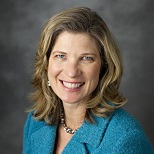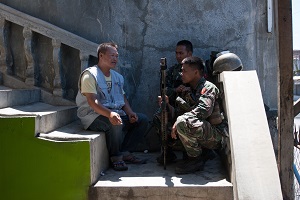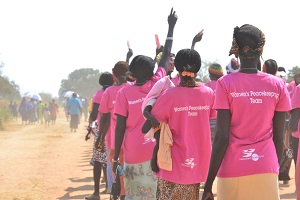 Special to the Philanthropy Journal
Special to the Philanthropy Journal
By Marna Anderson, MA
There are approximately 1.5 billion people currently living in countries where violence is endemic and nearly 60 million have been forcibly displaced by war. The images on social media, newspapers and the evening news show thousands of people fleeing their homes in search of safety and security. They are primarily civilians — people wanting to work, go to school, grow crops, take care of their families and live their lives in peace. But violent conflict has turned their worlds upside down, threatening their existence and way of life.
Nonviolent Peaceforce is a nonprofit organization that enters some of the most conflicted regions in the world to provide protection to civilians using unarmed and nonviolent strategies. A United Nations report from October 2015 states, “Unarmed civilian protection is a method for direct protection of civilians and violence reduction that has grown in practice and recognition. In the last few years, it has especially proven its effectiveness to protect women and girls.” Recognizing Nonviolent Peaceforce’s accomplishments in the field, the organization was recently nominated for the 2016 Nobel Peace Prize by the American Friends Service Committee, recipients of the Nobel Prize in 1946.
When co-founders David Hartsough and Mel Duncan met at the 1999 Hague Appeal for Peace, they realized they had a shared dream to create a civilian-trained peaceforce. By the end of the conference they had gathered others who shared their vision, and started laying out the foundation for the organization.
 David, Mel and their fellow founders constituted Nonviolent Peaceforce in 2002 at a convening event in Surajkund, India with peace advocates from 49 countries in attendance. One year later, Nonviolent Peaceforce had its first team in Sri Lanka. Currently, over 200 trained peacekeepers are employed by Nonviolent Peaceforce and live in the Philippines, South Sudan, Myanmar and the Middle East. Over 40% of the peacekeepers are women and nearly 60% are national staff from the countries where we work.
David, Mel and their fellow founders constituted Nonviolent Peaceforce in 2002 at a convening event in Surajkund, India with peace advocates from 49 countries in attendance. One year later, Nonviolent Peaceforce had its first team in Sri Lanka. Currently, over 200 trained peacekeepers are employed by Nonviolent Peaceforce and live in the Philippines, South Sudan, Myanmar and the Middle East. Over 40% of the peacekeepers are women and nearly 60% are national staff from the countries where we work.
Nonviolent Peaceforce’s mission is to protect civilians in violent conflicts through unarmed strategies; build peace side by side with local communities; and advocate for the wider adoption of these approaches to safeguard human lives and dignity.
Our largest number of protection workers are located in South Sudan, a country that has been embroiled in a civil war since 2013 after gaining its independence in 2011. During this time, gender-based violence has increased dramatically. Domestic violence, rape, and keeping girls out of school are commonplace. In response, a group of local women approached Nonviolent Peaceforce staff about creating peacekeeping teams to educate women and girls, provide protection to those being assaulted and work to prevent further incidents of violence. Nonviolent Peaceforce worked to help organize the teams and provide ongoing training in conflict analysis, mediation, negotiation, and violence against women.
 There are now 22 Women Peacekeeping Teams made up of 1,000 women. They help shelter victims of domestic violence, negotiate for peace with armed cattle ranchers, and intervene when young boys are being recruited into armed groups. “The women start to see themselves as having a role in peace and security, and through their actions they make themselves and their communities safer,” says Tiffany Easthom, former country director for South Sudan program and interim executive director. Through a grant from the Dutch government, Nonviolent Peaceforce is expanding its work and within three years will have doubled the number of teams — creating a groundswell of women empowered to bring peace and security to their communities and providing a foundation for the next generation to ensure safety for all.
There are now 22 Women Peacekeeping Teams made up of 1,000 women. They help shelter victims of domestic violence, negotiate for peace with armed cattle ranchers, and intervene when young boys are being recruited into armed groups. “The women start to see themselves as having a role in peace and security, and through their actions they make themselves and their communities safer,” says Tiffany Easthom, former country director for South Sudan program and interim executive director. Through a grant from the Dutch government, Nonviolent Peaceforce is expanding its work and within three years will have doubled the number of teams — creating a groundswell of women empowered to bring peace and security to their communities and providing a foundation for the next generation to ensure safety for all.
Nonviolent Peaceforce’s success lies in its core value of working side by side with local communities to help build civil society so that lasting peace can flourish. By hiring and training local community members to resolve conflict without violence, we ensure that peacebuilding and peacekeeping will continue long after a project concludes. Additionally, we only establish programs when invited, typically by a local non-governmental or civil society organization. Once invited, we meet key players, including commanders from opposing sides, local police, religious, business, and civil society leaders. We do not take sides in any conflict and work independently from any special interest group, political party, ideology or religion. These values create trusting relationships in the field and have lead to
With so many places around the globe where civilians need to be protected, Nonviolent Peaceforce plans to expand programming, increase the number of peacekeepers and assist other organizations to incorporate unarmed civilian protection into their work. Through partnerships with other civil society organizations and advocating for the adoption of unarmed strategies with the United Nations and governments, we will reduce violence in the world.
Marna Anderson is the Director of Development and Communications for Nonviolent Peaceforce and works out of the U.S. office in St. Paul, MN. Marna is a nonprofit leader with expertise in organizational effectiveness and major donor fundraising. She has served organizations focused on human rights, conservation and violence against women and children.





